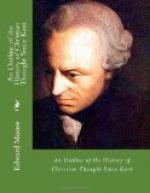LIFE OF JESUS
We said that the work of Strauss revealed nothing so clearly as the ignorance of his time concerning the documents of the early Christian movement. The labours of Baur and of his followers were directed toward overcoming this difficulty. Suddenly the public interest was stirred, and the earlier excitement recalled by the publication of a new life of Jesus. The author was a Frenchman, Ernest Renan, at one time a candidate for the priesthood in the Roman Church. He was a man of learning and literary skill, who made his Vie de Jesus, which appeared in 1863, the starting-point for a series of historical works under the general title, Les Origines de Christianisme. In the next year appeared Strauss’ popular work, Leben Jesu fuer das deutsche Volk. In 1864 was published also Weizsaecker’s contribution to the life of Christ, his Untersuchungen ueber die evangelische Geschichte. To the same year belonged Schenkel’s Charakterbild Jesu. In the years from 1867-1872 appeared Keim’s Geschichte Jesu von Nazara. There is something very striking in this recurrence to the topic. After ail, this was the point for the sake of which those laborious investigations had been undertaken. This was and is the theme of undying religious interest, the character and career of the Nazarene. Renan’s philosophical studies had been mainly in English, studies of Locke and Hume. But Herder also had been his beloved guide. For his biblical and oriental studies he had turned almost exclusively to the Germans. There is a deep religious spirit in the work of the period of his conflict with the Church. The enthusiasm for Christ sustained him in his struggle. Of the days before he withdrew from the Church he wrote: ’For two months I was a Protestant like a professor in Halle or Tuebingen.’ French was at that time a language much better known in the world at large, particularly the English-speaking world, than was German. Renan’s book had great art and charm. It took a place almost at once as a bit of world-literature. The number of editions in French and of translations into other languages is amazing. Beyond question, the critical position was made known through Renan to multitudes who would




